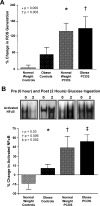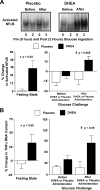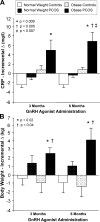Inflammation in Polycystic Ovary Syndrome: underpinning of insulin resistance and ovarian dysfunction
- PMID: 22178787
- PMCID: PMC3309040
- DOI: 10.1016/j.steroids.2011.12.003
Inflammation in Polycystic Ovary Syndrome: underpinning of insulin resistance and ovarian dysfunction
Abstract
Chronic low-grade inflammation has emerged as a key contributor to the pathogenesis of Polycystic Ovary Syndrome (PCOS). A dietary trigger such as glucose is capable of inciting oxidative stress and an inflammatory response from mononuclear cells (MNC) of women with PCOS, and this phenomenon is independent of obesity. This is important because MNC-derived macrophages are the primary source of cytokine production in excess adipose tissue, and also promote adipocyte cytokine production in a paracrine fashion. The proinflammatory cytokine tumor necrosis factor-α (TNFα) is a known mediator of insulin resistance. Glucose-stimulated TNFα release from MNC along with molecular markers of inflammation are associated with insulin resistance in PCOS. Hyperandrogenism is capable of activating MNC in the fasting state, thereby increasing MNC sensitivity to glucose; and this may be a potential mechanism for promoting diet-induced inflammation in PCOS. Increased abdominal adiposity is prevalent across all weight classes in PCOS, and this inflamed adipose tissue contributes to the inflammatory load in the disorder. Nevertheless, glucose ingestion incites oxidative stress in normal weight women with PCOS even in the absence of increased abdominal adiposity. In PCOS, markers of oxidative stress and inflammation are highly correlated with circulating androgens. Chronic suppression of ovarian androgen production does not ameliorate inflammation in normal weight women with the disorder. Furthermore, in vitro studies have demonstrated the ability of pro-inflammatory stimuli to upregulate the ovarian theca cell steroidogenic enzyme responsible for androgen production. These findings support the contention that inflammation directly stimulates the polycystic ovary to produce androgens.
Copyright © 2011 Elsevier Inc. All rights reserved.
Figures



Similar articles
-
Nutrient-Induced Inflammation in Polycystic Ovary Syndrome: Role in the Development of Metabolic Aberration and Ovarian Dysfunction.Semin Reprod Med. 2015 Jul;33(4):276-86. doi: 10.1055/s-0035-1554918. Epub 2015 Jul 1. Semin Reprod Med. 2015. PMID: 26132932 Review.
-
Source and amount of carbohydrate in the diet and inflammation in women with polycystic ovary syndrome.Nutr Res Rev. 2018 Dec;31(2):291-301. doi: 10.1017/S0954422418000136. Epub 2018 Jul 23. Nutr Res Rev. 2018. PMID: 30033891 Review.
-
The altered mononuclear cell-derived cytokine response to glucose ingestion is not regulated by excess adiposity in polycystic ovary syndrome.J Clin Endocrinol Metab. 2014 Nov;99(11):E2244-51. doi: 10.1210/jc.2014-2046. Epub 2014 Jul 31. J Clin Endocrinol Metab. 2014. PMID: 25078146 Free PMC article.
-
Inflammation Triggered by Saturated Fat Ingestion Is Linked to Insulin Resistance and Hyperandrogenism in Polycystic Ovary Syndrome.J Clin Endocrinol Metab. 2020 Jun 1;105(6):e2152-67. doi: 10.1210/clinem/dgaa108. J Clin Endocrinol Metab. 2020. PMID: 32140727 Free PMC article.
-
Saturated fat ingestion stimulates proatherogenic inflammation in polycystic ovary syndrome.Am J Physiol Endocrinol Metab. 2021 Nov 1;321(5):E689-E701. doi: 10.1152/ajpendo.00213.2021. Epub 2021 Oct 11. Am J Physiol Endocrinol Metab. 2021. PMID: 34632798 Free PMC article. Clinical Trial.
Cited by
-
Evaluation of the relationship between serum ferritin and insulin resistance and visceral adiposity index (VAI) in women with polycystic ovary syndrome.Eat Weight Disord. 2021 Jun;26(5):1581-1593. doi: 10.1007/s40519-020-00980-x. Epub 2020 Aug 8. Eat Weight Disord. 2021. PMID: 32772321
-
The combined impact of testosterone and Western-style diet on endometriosis severity and progression in rhesus macaques†.Biol Reprod. 2023 Jan 14;108(1):72-80. doi: 10.1093/biolre/ioac183. Biol Reprod. 2023. PMID: 36173894 Free PMC article.
-
Complement activation in polycystic ovary syndrome occurs in the postprandial and fasted state and is influenced by obesity and insulin sensitivity.Clin Endocrinol (Oxf). 2021 Jan;94(1):74-84. doi: 10.1111/cen.14322. Epub 2020 Sep 15. Clin Endocrinol (Oxf). 2021. PMID: 32865246 Free PMC article.
-
Effect of Central Obesity and Hyperandrogenism on Selected Inflammatory Markers in Patients with PCOS: A WHtR-Matched Case-Control Study.J Clin Med. 2020 Sep 20;9(9):3024. doi: 10.3390/jcm9093024. J Clin Med. 2020. PMID: 32962205 Free PMC article.
-
Genetic variation in the Mcp-1 gene promoter associated with the risk of polycystic ovary syndrome.PLoS One. 2015 Apr 22;10(4):e0123045. doi: 10.1371/journal.pone.0123045. eCollection 2015. PLoS One. 2015. PMID: 25902044 Free PMC article.
References
-
- The Rotterdam ESHRE/ASRM-Sponsored PCOS Conference Workshop Group. Revised 2003 consensus on diagnostic criteria and long-term health risks related to polycystic ovary syndrome. Fertil Steril. 2004;81:19–25. - PubMed
-
- Eisner JR, Barnett MA, Dumesic DA, Abbott DH. Ovarian hyperandrogenism in adult female rhesus monkeys exposed to prenatal androgen excess. Fertil Steril. 2002;1:167–72. - PubMed
-
- Wild RA, Carmina E, Diamanti-Kandarakis E, Dokras A, Escobar-Morreale HF, Futterweit W, et al. Assessment of the cardiovascular risk and prevention of cardiovascular disease in women with polycystic ovary syndrome: a consensus statement by the Androgen Excess and Polycystic Ovary Syndrome (AE-PCOS) Society. J Clin Endocrinol Metab. 2010;95:2038–49. - PubMed
-
- Azziz R, Carmina E, Dewailly D, Diamanti-Kandarakis E, Escobar-Morreale HF, Futterweit W, et al. Task Force on the Phenotype of the Polycystic Ovary Syndrome of The Androgen Excess and PCOS Society. The Androgen Excess and PCOS Society criteria for the polycystic ovary syndrome: the complete task force report. Fertil Steril. 2009;96:456–88. - PubMed
-
- González F, Rote NS, Minium J, Kirwan JP. Increased activation of nuclear factor kB triggers inflammation and insulin resistance in polycystic ovary syndrome. Journal of Clin Endocrinol Metab. 2006;91:1508–12. - PubMed
Publication types
MeSH terms
Grants and funding
LinkOut - more resources
Full Text Sources
Other Literature Sources
Medical

